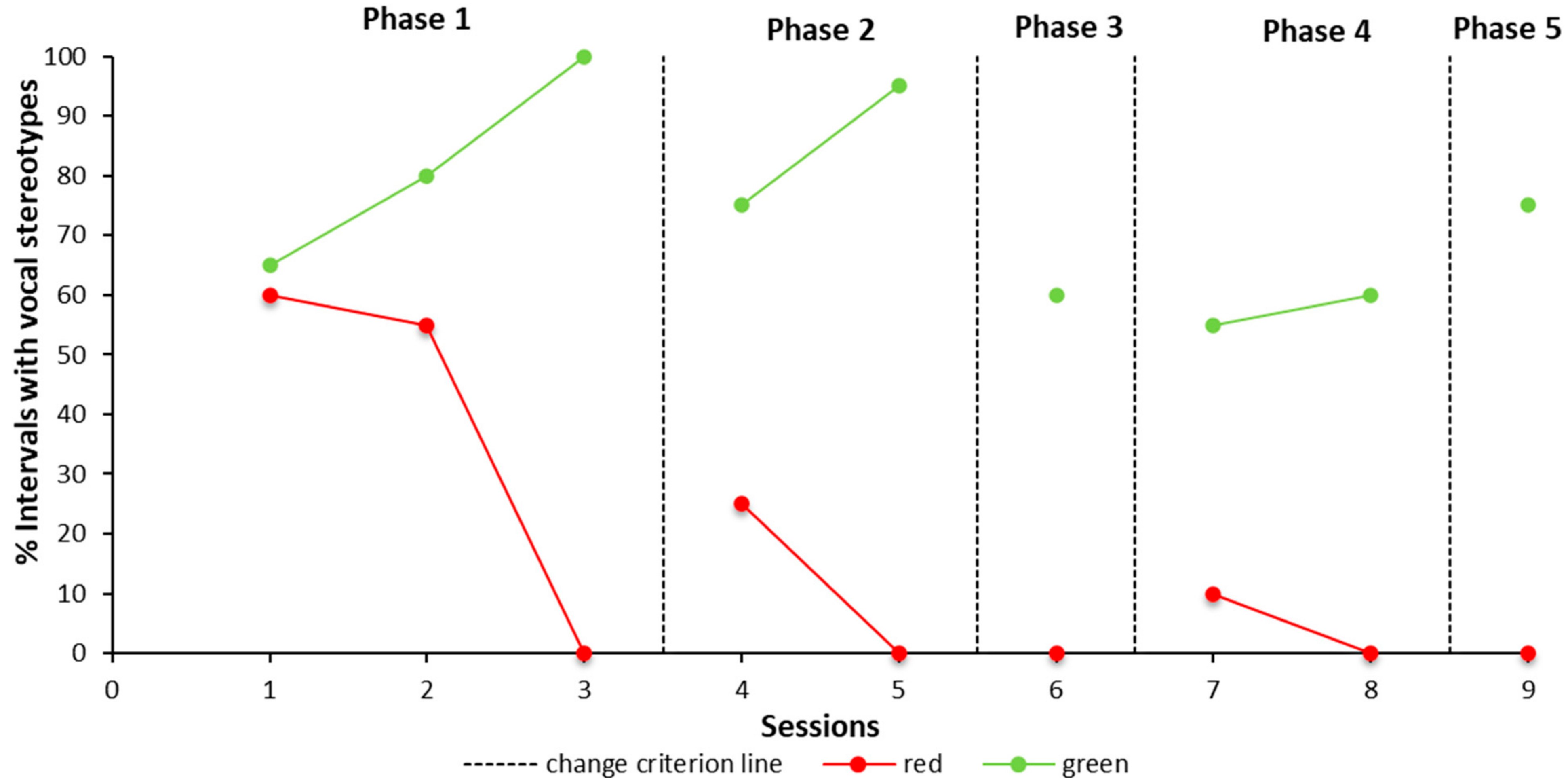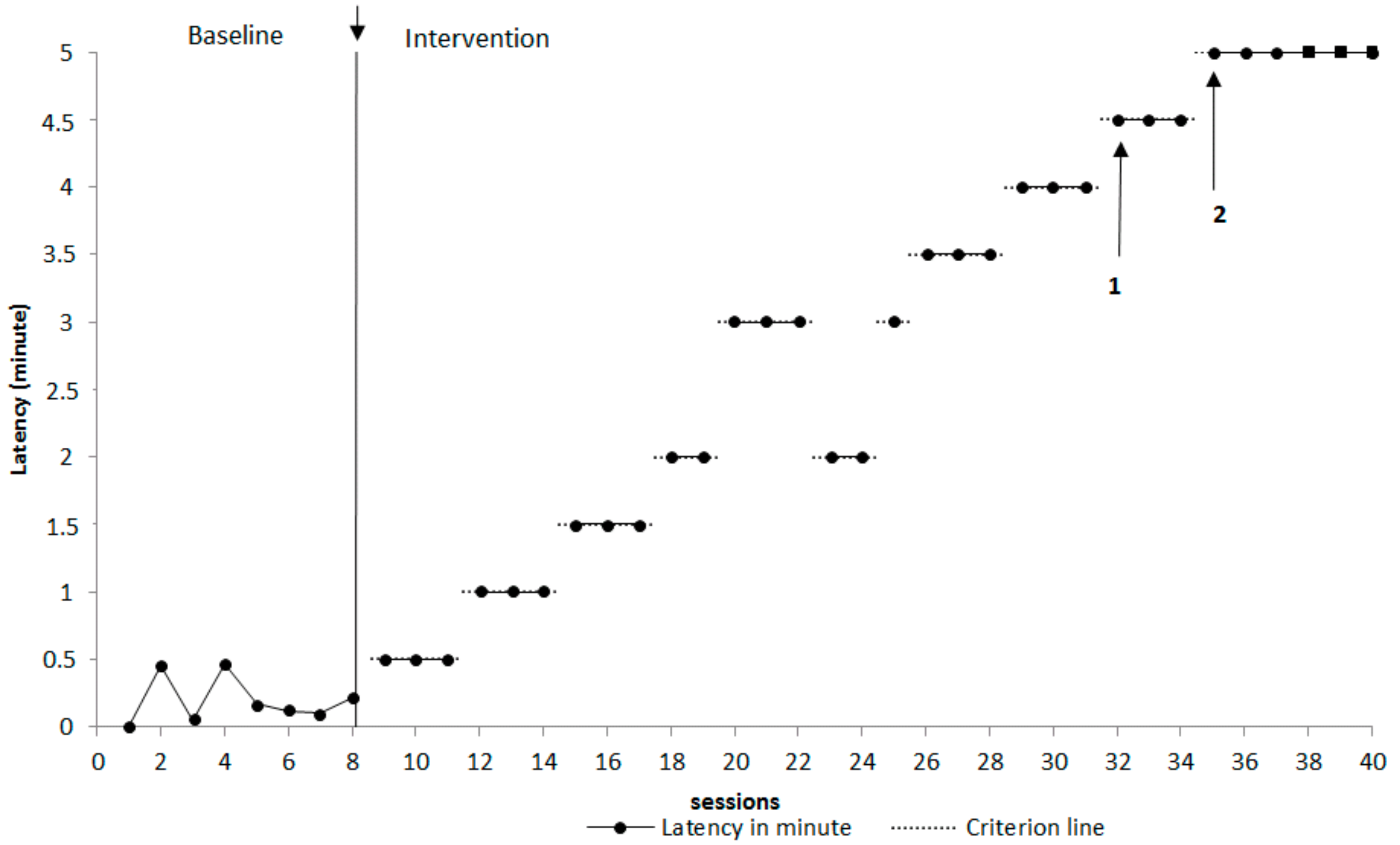Stimulus Control Procedure for Reducing Vocal Stereotypies in an Autistic Child
Abstract
:1. Introduction
1.1. Function Analysis of Stereotypies
1.2. Behavioral Interventions
2. Method
2.1. Participant
2.2. Setting and Materials
2.3. Data Collection and Dependent Variable
2.4. Experimental Design
2.5. Procedure: Baseline, Discrimination Training and Intervention
2.6. Generalization of the Intervention
3. Results
4. Discussion
5. Conclusions
Author Contributions
Funding
Institutional Review Board Statement
Informed Consent Statement
Data Availability Statement
Conflicts of Interest
References
- APA—American Psychiatric Association. Diagnostic and Statistical Manual of Mental Disorders—DSM 5; APA: Washington, DC, USA, 2013. [Google Scholar]
- Wong, C.; Odom, S.L.; Hume, K.A.; Cox, A.W.; Fettig, A.; Kucharczyk, S.; Brock, M.E.; Plavnick, J.B.; Fleury, V.P.; Schultz, T.R. Evidence-based practices for children, youth, and young adults with autism spectrum disorder: A comprehensive review. J. Autism Dev. Disord. 2015, 45, 1951–1966. [Google Scholar] [CrossRef] [PubMed]
- Rapp, J.T.; Vollmer, T.R. Stereotypy I: A review of behavioral assessment and treatment. Res. Dev. Disabil. 2005, 26, 527–547. [Google Scholar] [CrossRef]
- Lanovaz, M.J.; Sladeczek, I.E. Vocal stereotypy in children with autism: Structural characteristics, variability, and effects of auditory stimulation. Res. Autism Spectr. Disord. 2011, 5, 1159–1168. [Google Scholar] [CrossRef]
- Sundberg, M.L. Verbal Behavior Milestones Assessment and Placement Program: The VBMAPP; AVB Press: Concord, CA, USA, 2008. [Google Scholar]
- Koegel, R.L.; Covert, A. The relationship of self-stimulation to learning in autistic children. J. Appl. Behav. Anal. 1972, 5, 381–387. [Google Scholar] [CrossRef] [PubMed] [Green Version]
- Koegel, R.L.; Firestone, P.B.; Kramme, K.W.; Dunlap, G. Increasing spontaneous play by suppressing self-stimulation in autistic children 1. J. Appl. Behav. Anal. 1974, 7, 521–528. [Google Scholar] [CrossRef] [Green Version]
- Lanovaz, M.J.; Robertson, K.M.; Soerono, K.; Watkins, N. Effects of reducing stereotypy on other behaviors: A systematic review. Res. Autism Spectr. Disord. 2013, 7, 1234–1243. [Google Scholar] [CrossRef]
- Cook, J.L.; Rapp, J.T. To what extent do practitioners need to treat stereotypy during academic tasks? Behav. Modif. 2020, 44, 228–264. [Google Scholar] [CrossRef]
- Coon, J.C.; Rapp, J.T. Brief report: Evaluating college students’ perceptions of a child displaying stereotypic behaviors: Do changes in stereotypy levels affect ratings? J. Autism Dev. Disord. 2020, 50, 1827–1833. [Google Scholar] [CrossRef]
- Ahearn, W.H.; Clark, K.M.; DeBar, R.; Florentino, C. On the role of preference in response competition. J. Appl. Behav. Anal. 2005, 38, 247–250. [Google Scholar] [CrossRef] [Green Version]
- Taylor, B.A.; Hoch, H.; Weissman, M. The analysis and treatment of vocal stereotypy in a child with autism. Behav. Interv. 2005, 20, 239–253. [Google Scholar] [CrossRef]
- Falcomata, T.S.; Roane, H.S.; Hovanetz, A.N.; Kettering, T.L.; Keeney, K.M. An evaluation of response cost in the treatment of inappropriate vocalizations maintained by automatic reinforcement. J. Appl. Behav. Anal. 2004, 37, 83–87. [Google Scholar] [CrossRef]
- Fay, W.H. On the basis of autistic echolalia. J. Commun. Disord. 1969, 2, 31–41. [Google Scholar] [CrossRef]
- Ahearn, W.H.; Clark, K.M.; Gardener, N.C.; Chung, B.I.; Dube, W.V. Persistence of stereotypic behavior: Examining the effects of external reinforcers. J. Appl. Behav. Anal. 2003, 36, 439–448. [Google Scholar] [CrossRef] [PubMed] [Green Version]
- Durand, V.M.; Carr, E.G. Social influences on “self-stimulatory” behavior: Analysis and treatment application. J. Appl. Behav. Anal. 1987, 20, 119–132. [Google Scholar] [CrossRef] [PubMed] [Green Version]
- Kennedy, C.H.; Meyer, K.A.; Knowles, T.; Shukla, S. Analyzing the multiple functions of stereotypical behavior for students with autism: Implications for assessment and treatment. J. Appl. Behav. Anal. 2000, 33, 559–571. [Google Scholar] [CrossRef] [PubMed] [Green Version]
- Repp, A.C.; Felce, D.; Barton, L.E. Basing the treatment of stereotypic and self-injurious behaviors on hypotheses of their causes. J. Appl. Behav. Anal. 1988, 21, 281–289. [Google Scholar] [CrossRef] [PubMed] [Green Version]
- Lovaas, O.I.; Newsom, C.; Hickman, C. Self Stimulatory behavior and perceptual reinforcement. J. Appl. Behav. Anal. 1987, 20, 45–68. [Google Scholar] [CrossRef] [PubMed] [Green Version]
- Lanovaz, M.J.; Sladeczek, I.E. Vocal stereotypy in individuals with autism spectrum disorders: A review of behavioral interventions. Behav. Modif. 2012, 36, 146–164. [Google Scholar] [CrossRef]
- Vollmer, T.R. The concept of automatic reinforcement: Implications for behavioral research in developmental disabilities. Res. Dev. Disabil. 1994, 15, 187–207. [Google Scholar] [CrossRef]
- Ahearn, W.H.; Clark, K.M.; MacDonald, R.P.F.; Chung, B.I. Assessing and treating vocal stereotypy in children with autism. J. Appl. Behav. Anal. 2007, 40, 263–275. [Google Scholar] [CrossRef] [Green Version]
- Athens, E.S.; Vollmer, T.R. An analysis of vocal stereotypy and therapist fading. J. Appl. Behav. Anal. 2008, 41, 291–298. [Google Scholar] [CrossRef] [PubMed] [Green Version]
- Cassella, M.D.; Sidener, T.M.; Sidener, D.W.; Progar, P.R. Response interruption and redirection for vocal stereotypy in children with autism: A systematic replication. J. Appl. Behav. Anal. 2011, 44, 169–173. [Google Scholar] [CrossRef] [PubMed] [Green Version]
- Love, J.J.; Miguel, C.F.; Fernand, J.K.; LaBrie, J.K. The effects of matched stimulation and response interruption and redirection on vocal stereotypy. J. Appl. Behav. Anal. 2012, 45, 549–564. [Google Scholar] [CrossRef] [PubMed] [Green Version]
- Behavior Analyst Certification Board. BACB Professional and Ethical Compliance Code for Behavior Analysts. 2017. Available online: https://www.bacb.com/wp-content/uploads/2020/05/BACB-Compliance-Code-english_190318.pdf (accessed on 25 October 2021).
- Rapp, J.T.; Patel, M.R.; Ghezzi, P.M.; O’Flaherty, C.H.; Titterington, C.J. Establishing stimulus control of vocal stereotypy displayed by young children with autism. Behav. Interv. 2009, 24, 85–105. [Google Scholar] [CrossRef]
- Rapp, J.T. Toward an empirical method for identifying matched stimulation for automatically reinforced behavior: A preliminary investigation. J. Appl. Behav. Anal. 2006, 39, 137–140. [Google Scholar] [CrossRef] [PubMed] [Green Version]
- Cooper, J.O.; Heron, T.E.; Heward, W.L. Applied Behavior Analysis, 2nd ed.; Pearson Prentice Hall: Upper Saddle River, NJ, USA, 2007. [Google Scholar]
- Green, G. Behavior analytic instruction for learners with autism: Advances in stimulus control technology. Focus Autism Other Dev. Disabil. 2001, 16, 72–85. [Google Scholar] [CrossRef] [Green Version]
- Miller, T.L.; Lignugaris-Kraft, B. The effects of text structure discrimination training on the performance of students with learning disabilities. J. Behav. Educ. 2002, 11, 203–230. [Google Scholar] [CrossRef]
- Brusa, E.; Richman, D. Developing stimulus control for occurrences of stereotypy exhibited by a child with autism. Int. J. Behav. Consult. Ther. 2008, 4, 264. [Google Scholar] [CrossRef] [Green Version]
- Doughty, S.S.; Anderson, C.M.; Doughty, A.H.; Williams, D.C.; Saunders, K.J. Discriminative control of punished stereotyped behavior in humans. J. Exp. Anal. Behav. 2007, 87, 325–336. [Google Scholar] [CrossRef] [Green Version]
- Haley, J.L.; Heick, P.F.; Luiselli, J.K. Use of an antecedent intervention to decrease vocal stereotypy of a student with autism in the general education classroom. Child Fam. Behav. Ther. 2010, 32, 311–321. [Google Scholar] [CrossRef]
- McKenzie, S.D.; Smith, R.G.; Simmons, J.N.; Soderlund, M.J. Using a stimulus correlated with reprimands to suppress automatically maintained eye poking. J. Appl. Behav. Anal. 2008, 41, 255–259. [Google Scholar] [CrossRef] [PubMed] [Green Version]
- O’Connor, A.S.; Prieto, J.; Hoffmann, B.; DeQuinzio, J.A.; Taylor, B.A. A stimulus control procedure to decrease motor and vocal stereotypy. Behav. Interv. 2011, 26, 231–242. [Google Scholar] [CrossRef]
- Cook, J.L.; Rapp, J.T.; Gomes, L.A.; Frazer, T.J.; Lindblad, T.L. Effects of verbal reprimands on targeted and untargeted stereotypy. Behav. Interv. 2014, 29, 106–124. [Google Scholar] [CrossRef]
- Kenny, L.; Hattersley, C.; Molins, B.; Buckley, C.; Povey, C.; Pellicano, E. Which terms should be used to describe autism? Perspectives from the UK autism community. Autism 2016, 20, 442–462. [Google Scholar] [CrossRef] [PubMed]
- Partington, J.W. The Assessment of Basic Language and Learning Skills—Revised (ABLLS–R); Behavior Analysts: Walnut Hill, CA, USA, 2006. [Google Scholar]
- Gossou, K.M.; Lanovaz, M.J.; Giannakakos, A. Concurrent Validity of Functional Analysis, ABC Narrative Recordings, and Open-Ended Functional Assessment Interviews. PsyArXiv 2020. [Google Scholar] [CrossRef]
- Neely, L.; Gerow, S.; Rispoli, M.; Lang, R.; Pullen, N. Treatment of echolalia in individuals with autism spectrum disorder: A systematic review. Rev. J. Autism Dev. Disord. 2016, 3, 82–91. [Google Scholar] [CrossRef]
- Dickman, S.E.; Bright, C.N.; Montgomery, D.H.; Miguel, C.F. The effects of response interruption and redirection (RIRD) and differential reinforcement on vocal stereotypy and appropriate vocalizations. Behav. Interv. 2012, 27, 185–192. [Google Scholar] [CrossRef]
- Shawler, L.A.; Dianda, M.; Miguel, C.F. A comparison of response interruption and redirection and competing items on vocal stereotypy and appropriate vocalizations. J. Appl. Behav. Anal. 2020, 53, 355–365. [Google Scholar] [CrossRef] [Green Version]
- Call, N.A.; Simmons, C.A.; Mevers, J.E.L.; Alvarez, J.P. Clinical outcomes of behavioral treatments for pica in children with developmental disabilities. J. Autism Dev. Disord. 2015, 45, 2105–2114. [Google Scholar] [CrossRef] [PubMed]
- Fontani, S. Interventi educativi Evidence Based per la diminuzione delle stereotipie nei Disturbi dello Spettro Autistico. Ital. J. Spec. Educ. Incl. 2016, 4, 67–83. Available online: https://www.researchgate.net/publication/323074926 (accessed on 25 October 2021).


| Sessions (Range) | Criterion Time (Seconds) |
|---|---|
| 1–8 | baseline |
| 9–11 | 30 |
| 12–14 | 60 |
| 15–17 | 90 |
| 18–19 | 120 |
| 20–22 | 180 |
| 23–24 | 120 (>stereotypies) |
| 25–25 | 180 |
| 26–28 | 210 |
| 29–31 | 240 |
| 32–34 | 270 (fading green card) |
| 35–40 | 300 (no card) |
Publisher’s Note: MDPI stays neutral with regard to jurisdictional claims in published maps and institutional affiliations. |
© 2021 by the authors. Licensee MDPI, Basel, Switzerland. This article is an open access article distributed under the terms and conditions of the Creative Commons Attribution (CC BY) license (https://creativecommons.org/licenses/by/4.0/).
Share and Cite
Esposito, M.; Pignotti, L.; Mondani, F.; D’Errico, M.; Ricciardi, O.; Mirizzi, P.; Mazza, M.; Valenti, M. Stimulus Control Procedure for Reducing Vocal Stereotypies in an Autistic Child. Children 2021, 8, 1107. https://doi.org/10.3390/children8121107
Esposito M, Pignotti L, Mondani F, D’Errico M, Ricciardi O, Mirizzi P, Mazza M, Valenti M. Stimulus Control Procedure for Reducing Vocal Stereotypies in an Autistic Child. Children. 2021; 8(12):1107. https://doi.org/10.3390/children8121107
Chicago/Turabian StyleEsposito, Marco, Laura Pignotti, Federica Mondani, Martina D’Errico, Orlando Ricciardi, Paolo Mirizzi, Monica Mazza, and Marco Valenti. 2021. "Stimulus Control Procedure for Reducing Vocal Stereotypies in an Autistic Child" Children 8, no. 12: 1107. https://doi.org/10.3390/children8121107
APA StyleEsposito, M., Pignotti, L., Mondani, F., D’Errico, M., Ricciardi, O., Mirizzi, P., Mazza, M., & Valenti, M. (2021). Stimulus Control Procedure for Reducing Vocal Stereotypies in an Autistic Child. Children, 8(12), 1107. https://doi.org/10.3390/children8121107







